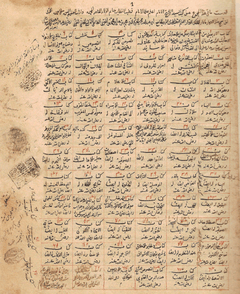Khatm ul Awliya
The Seal of the Saints or "Khatam ul Awliya" is a central concept in the writings of 12th-century Islamic thinker and spiritual leader Ibn Arabi.

Concept of The Seal of the Saints in Ibn Arabi's writings
Ibn Arabi (1165-1240), in his "Meccan Revelation" ("Futuhati Maqiyya"),[1] explains that all the prophets and saints derive their light from the spirit of Muhammad, the prophet of Islam.[2]
In Ibn Arabi's thinking, the prophets and saints are manifestations of the spirit of Muhammad, which is the start and end point of the whole spiritual hierarchy. The first manifestation of the spirit of Muhammad was the first man, Adam. The last and most perfect was Muhammad himself.
Two lines of spiritual transmission
In the mystical branch of Islam, Sufism, there are two main lines of spiritual transmission:
- The 40 tariqas, which trace their line of Spiritual Transmission through Ali Ibn abi Thalib to the prophet Muhammad. The Seal of Saints of the 40 Tariqas line is said to be Ibn Arabi himself.[3]
- The chain of transmission which runs through Abu Bakr as-Ṣiddīq to Muhammad. The Seal of Saints of the Abu Bakr as-Ṣiddīq line is Abdullah Faiz Dagistani. This is the Naqshbandi (or Siddiqi) Tariqa.[4]
Ibn Arabi, in his book "The Astonishing Phoenix – on the Seal of the Saints and the Sun of the West", explains that the name of the Seal of Saints is Abdullah, who is a despised ajami.[4] Ibn Arabi describes the Seal of Saints in detail, using notably difficult symbolic language.
Similarly, Sharafuddin ad Dagistani, Moulana Sheikh Nazim and Adnan Kabbani explain that the Seal of Saints of the Siddiqi or Naqshbandi Tariqa is Abdullah Faiz Dagistani.[4]
Bibliography
- Michel Chodkiewicz (author). Liadain Sherrard (translator). The Seal of the Saints. Prophethood and Sainthood in the Doctrine of Ibn 'Arabi. The Islamic Texts Society. 1993.
- Gerald T. Elmore. Islamic Sainthood in the Fullness of Time: Ibn al-'Arabi's Book of the Fabulous Gryphon. Koninklijke Brill, The Netherlands, 1998. ISBN 90-04-10991-9 (Chapter VI. The Seal of the Saints.) Google books
- A. E. Affifi. The Mystical Philosophy of Muhyid Din-ibnul Arabi. Cambridge University Press, 1939. Google books
- Toshihiko Izutsu Sufism and Taoism: a comparative study of key philosophical concepts. University of California Press, 1984 Google books
See also
- List of Sufis influenced by Ibn 'Arabī
References
- Al Arabi, Ibn; Chodkiewicz, Michel; Morris, James W. (2002). Meccan Revelations 1. Pir Press. ISBN 978-1-879708-16-7.
- Chodkiewicz, Michel. Seal of the Saints: Prophethood and Sainthood in the Doctrine of Ibn 'Arabi. Fons Vitae. ISBN 0-946621-40-3.
- Toshihiko Izutsu. Sufism and Taoism, page 270
- Khatm ul Awliya (The Seal of Saints), Sheikh Abdullah Faiz Daghistan Retrieved 15 October 2011
External links
- The Seal of Saints: Abu Bakr us Siddique line: Sheikh Abdullah Faiz Daghistani
- Extracts from The Wisdom of the Prophets by Ibn Arabi
- Dar-Sirr "The Sparkled Bridegroom in the Concealness and Sealness of Abil Abbas Tijani the Phoenix"
- Ibn al-'Arabī's Book of the Fabulous Gryphon ('Anqā' Mughrib)
- Review of Chodkiewicz's Seal of the Saints by James Morris